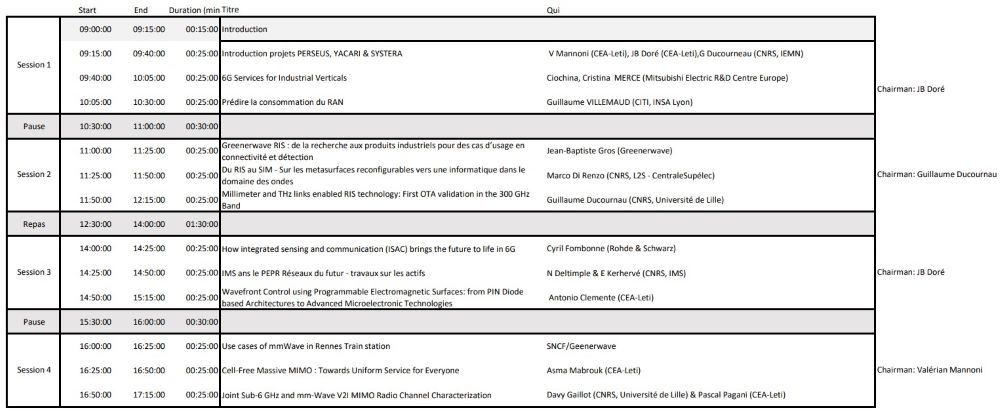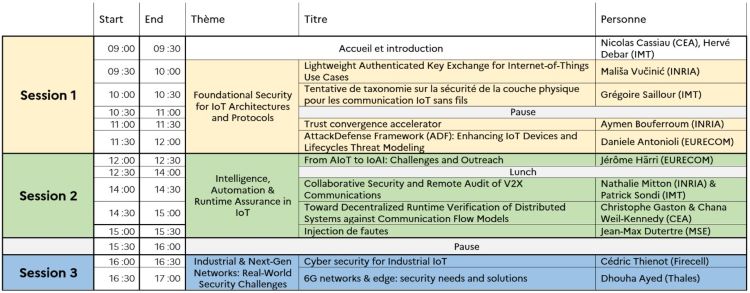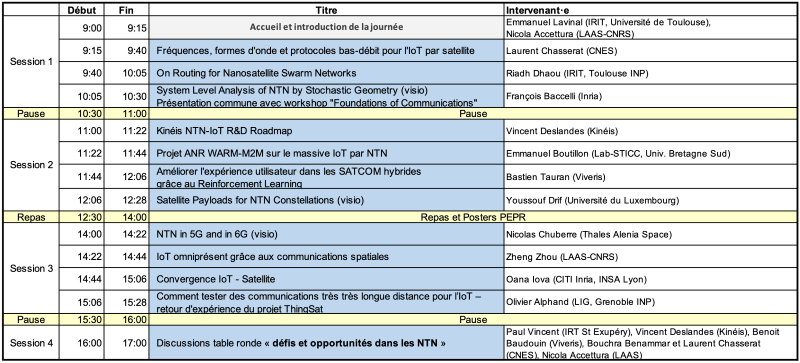
|
|
|
WorkshopsTemps fort de ce séminaire : workshops du mardi 3 juin ! Lors de votre inscription au séminaire, vous pourrez sélectionner 1 workshop auquel vous souhaitez assister. Le jour-J, il sera possible, suivant la disponibilité dans les salles, de naviguer entre les workshops. ⚠️ Certains workshops ne pourront accueillir une capacité de 100 personnes, vous recevrez un mail de confirmation suite à votre inscription pour valider le workshop auquel vous assisterez.
Workshop 1 6G Low Layers : Bridging Components and System Design AMPHI B Comité d'organisation :
Résumé du workshop : La transition vers les réseaux 6G est au cœur de travaux de R&D, ouvrant la voie à la prochaine phase des efforts de normalisation. Cette évolution repose sur l’exploration de nouvelles bandes de fréquences, telles que FR3 et le spectre térahertz (THz), tout en optimisant les performances des bandes FR2 sub-6 GHz et mmWave existantes grâce à des architectures et technologies avancées. Des innovations clés, telles que les surfaces intelligentes reconfigurables (RIS), le MIMO distribué, la fusion des communications et de la détection, ainsi que les prochaines générations d’électronique RF et de systèmes d’antennes, jouent un rôle central dans cette transformation. Cet atelier constitue une plateforme d’échange, couvrant l’ensemble des avancées en technologies radio, de la conception des composants à leur intégration système. Il offrira aux participants un aperçu des dernières avancées de la recherche académique et des perspectives industrielles, avec un accent particulier sur les résultats récents du projet PEPR. En réunissant experts académiques et industriels, l’atelier favorisera des discussions approfondies sur les innovations qui façonneront l’avenir des communications sans fil.
Workshop 2 Securing the IoT Ecosystem: A holistic Approach from Device to Network AMPHI D Comité d'organisation :
Résumé du workshop : Cet atelier réunit des experts des projets PEPR-FITNESS et PEPR-HiSEC, ainsi que des professionnels de l'industrie, afin d'explorer les multiples facettes du défi que représente la sécurisation de l'écosystème de l'internet des objets (IoT). Les projets FITNESS et HiSEC étudient les systèmes de bout en bout, depuis le cœur de réseau jusqu'aux appareils, en se focalisant respectivement sur les défis à relever pour l'IoT – FITNESS – et sur la sécurité des réseaux – HiSEC. En combinant leur expertise, cet atelier offre une vision holistique de la sécurité de l'IoT. Les participants pourront assister à un large éventail de présentations, d'études de cas et de sessions interactives qui se penchent sur les défis uniques en matière de sécurité et sur les solutions innovantes dans les appareils IoT et les réseaux futurs. Les sujets abordés seront entre autres les approches de sécurité basées sur le matériel, l’architecture AI as a Service sécurisée par blockchain, les modèles de sécurité collaborative pour les communications V2X, la protection des réseaux (protection des slices, politiques de sécurité edge), la détection des attaques (détection comportementale), et l'interception légale. Cet atelier encourage la participation active et l'échange de connaissances entre les participants grâce notamment à des discussions en panel. En comblant le fossé entre le monde universitaire et l'industrie, cet événement vise à accélérer le développement et le déploiement de solutions de sécurité IoT robustes et de bout en bout.
Pour suivre le workshop 2 à distance :
Participer à la réunion Zoom
Jour: 3 juin
Code animateur: 176510
Workshop 3 Progress and Challenges in Non-Terrestrial Networks (NTN) AMPHI E Comité d'organisation :
Résumé du workshop : Les réseaux non terrestres (NTN) transforment la connectivité mondiale en intégrant les communications par satellite, les systèmes de plateformes à haute altitude (HAPS) et les réseaux de drones. Ce workshop réunira experts académiques et industriels pour explorer les avancées et défis des NTN. Les principaux sujets abordés sur ces systèmes à haute altitude et constellations de satellites incluront la gestion des ressources, le routage, l'interopérabilité avec les réseaux terrestres, la connectivité directe par satellite pour les réseaux IoT ou 5G/6G, ainsi que l'analyse des performances de ces réseaux.
Workshop 4 Perspectives on the Foundations of Communications for Future Networks AMPHI A Comité d'organisation :
Résumé du workshop : Future wireless networks will be driven by diverse applications ranging from immersive reality, autonomous vehicles, distributed machine learning and computation, or large-scale sensing. These networks will also involve new technologies such as RIS and massive/cell-free MIMO, or new media at THz/mmWave frequencies, and in space with emerging non-terrestrial networks. At the same time, emerging applications are imposing both stricter reliability, latency, and energy requirements as well as new end-to-end constraints with the rise of semantic communications and distributed computing. Design and validation needs are forcing a rethink of fundamental aspects of communication theory: modelling; information-theoretic limits; and algorithmic complexity. This workshop will focus on three main topics:
Pour suivre ce workshop à distance : Jour: 3 juin
Code animateur: 63689
Abstract des intervenants : Mohammed Karray : Title : QoS Modeling in Large Cellular Networks: A Unified Information, Queueing, and Stochastic Geometry Framework Authors : B. Błaszczyszyn, L. Darlavoix, M.K. Karray Presenter : M.K. Karray Abstract : This presentation introduces a unified analytical framework for modeling Quality of Service (QoS), particularly user throughput, in large 4G and 5G cellular networks. By integrating information theory (for link performance/MIMO), queueing theory (for traffic dynamics), and stochastic geometry (for network topology/interference), we derive key metrics like cell load, number of users, and throughput. The model is validated against real-world operational data, demonstrating its effectiveness for network analysis and dimensioning. Marco Di Renzo : Title : degrees of freedom for holographic MIMO based on EM models Francois Baccelli : Title : System Level Analysis of NTN by Stochastic Geometry Anne Bouillard : Title: Guaranteed performance analysis of networks with bandwidth-sharing schedulers Abstract: Deficit Round-Robin (DRR) is a scheduling algorithm that is often used in real-time systems or communication networks for scheduling tasks, or packets. This scheduling algorithm guarantees a share of the bandwidth to each class of traffic, proportional to its assigned quantum. This is an example of bandwidth-sharing policy. Analyzing a bandwidth-sharing policy network requires two steps. The first step is a single-node analysis to compute the service that is guaranteed to each class of traffic. Recent work show that knowing the characteristics of the cross-traffic can improve this guarantee. The second step is a per-class analysis. When all per-node guarantees have been computed, one FIFO network per class can be constructed, and delay bounds can be computed. In this talk, we will show how these two steps are interdependent, especially when the DRR network has cyclic dependencies, and present an iterative scheme that improves both the performance bounds and stability region compared to the state of the art. Maxime Guillaud : Title : Geometric methods in digital communications Abstract : I will discuss several cases where geometric arguments can be leveraged in telecommunications scenario. First, I will discuss the design of constellations on the Grassmann manifold with both enjoying good packing properties and for which low-complexity approximate quantization is possible; applications range from non-coherent communications to channel state information quantization. Subsequently I will discuss how tensor algebra and more specifically the unique decomposition property of low-rank tensors can be leveraged to design waveforms suitable for massive random access scenarios. Arseniy Chorti : Title: Physical layer security in 6G: From theory to practice Abstract: Physical layer security is being considered for 6G due to its potential to provide solutions for delay, power and computationally constrained 6G systems. Motivated by this, the aim of this talk is twofold. First, we make the case that physical awareness, attained thanks to novel 6G radio capabilities, will be an enabler of PLS. Secondly, we demonstrate how fundamental information theoretic metrics can serve as design criteria for realistic PLS systems. As a concrete use case, this talk focuses on a novel authentication and key agreement (AKA) scheme that integrates physical layer authentication (PLA) and secret key generation (SKG) to enable fast and low-footprint AKA, that is provably robust against both passive and active attacks. Looking ahead, we discuss future steps towards standardization efforts to facilitate real-world deployment and ensure interoperability in emerging 6G networks. Fotios Stavrou : Title: On distributionally robust lossy source coding Abstract: This talk introduces a distributionally robust framework for lossy source coding under model uncertainty. Classical rate-distortion theory assumes known source statistics, which is often unrealistic. We develop a robust extension incorporating worst-case guarantees over ambiguity sets defined by KL-balls. Key results include robust versions of the Strong Functional Representation Lemma and new one-shot and asymptotic achievability theorems. The theory naturally extends to perceptual distortion metrics, yielding a robust rate-distortion-perception function. We illustrate analytical results for Bernoulli sources with Hamming distance and discuss optimization formulations, duality, and future research directions. Alvaro Valcarce : Title: Training the Future: Realizing the AI-Native Air Interface Abstract: Future wireless networks demand a paradigm shift beyond human-designed protocols towards systems that learn and adapt. At Nokia Bell-Labs, we are pioneering the AI-native Air Interface (AI-AI), envisioning networks trained by AI, not just designed by engineers. This talk explores this vision, focusing on how AI can fundamentally reshape the entire protocol stack. We will showcase groundbreaking research where AI learns complex communication behaviors: Deep Reinforcement Learning agents mastering intricate radio resource scheduling, transformer models compressing control signaling for greater efficiency, Large AI Models emulating the RRC layer's decision-making by treating protocols as a language, and multi-agent systems jointly learning optimal MAC signaling and access policies directly from experience. These examples highlight a transformative path towards intelligent, self-evolving networks. Maël Le Treust : Title: Achievability and converse bounds for the mismatched distortion-rate function (joint work with Tristan Tomala, HEC) Abstract: We investigate the mismatched distortion-rate problem formulated by Lapidoth in 1997. The single-letter characterization of the distortion-rate tradeoff is an open problem. When the rate is large enough, the mismatched distortion-rate problem is deeply related to the mechanism design problem formulated by Jackson and Sonnenschein in 2007. Inspired by this solution, we formulate a new converse bound that matches the achievability bound in four special cases: 1) when the rate is large enough, 2) when the source is binary and uniform and the decoder output is binary, 3) when the encoder distortion measure does not depend on the source symbols, 4) when the sum of the two distortion measures is zero. An important feature of the model is the stochastic post-processing of the codewords. By carefully selecting the randomness of the decoding function, it is optimal for the encoder to correctly transmit the source. Petros Ellias : Title : Multi-user distributed computing and the deep connections with coding theory, compressed sensing, and tessellation Abstract : In this work, we investigate the problem of multi-user distributed computing, where various servers help compute the desired linearly separable (but generally non-linear) functions of various users. We explore the classical problem of the tradeoff between computation cost, communication cost, and errors, and we establish novel relationships with coding theory and compressed sensing and tessellation theory. Table ronde : Introduction : Michele Wigger Participants : Mohammed Karray, Alvaro Valcarce, Jean-Marie Gorce, Marco Di Renzo, Anne Bouillard
Workshop 5 Evolution of industries as networks and cloud technologies progressively converge Comité d'organisation :
WORKSHOP ANNULE
|





